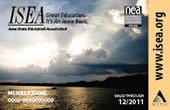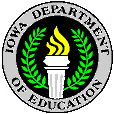A lot has happened the last couple of weeks. I will start with the most recent event and that is the release of the Governor's budget. We are still checking facts but these are some basic items pulled from his two year budget that have our attention:
1. The Governor is proposing elimination of the Statewide Voluntary Preschool Program as it currently exists and establishing a new funding stream to provide means-tested preschool funding to benefit economically disadvantaged four-year-olds. The proposal is funded in FY 2012 and FY
2013 by:
Friday, January 28, 2011
ISEA HOTLINE 1/28/2011
Governor Branstad cuts education in his Condition of the Budget
Governor Branstad is balancing the budget on the backs of our kids. In his Condition of the Budget report released January 27, Governor Branstad recommends $9.2 million in cuts to Iowa's community colleges, 0 percent allowable growth for K-12, an additional $27 million reduction to AEAs, and the elimination of the Statewide Voluntary Preschool Program.
Governor Branstad is balancing the budget on the backs of our kids. In his Condition of the Budget report released January 27, Governor Branstad recommends $9.2 million in cuts to Iowa's community colleges, 0 percent allowable growth for K-12, an additional $27 million reduction to AEAs, and the elimination of the Statewide Voluntary Preschool Program.
Labels:
Hotlines
Thursday, January 27, 2011
ISEA HOTLINE 1/27/2010
"Upon the subject of education, not presuming to dictate any plan or system respecting it,
I can only say that I view it as the most important subject which we as a people may be engaged in." --Abraham Lincoln
Allowable Growth = Cost of Living Adjustment
The Governor and House Republicans have proposed 0 percent Allowable Growth for Iowa’s public schools. In practical terms this means public schools will not see any cost of living adjustments to their budgets for the first time in 30 years. While schools will receive money for the current per-pupil spending, the money will not be adjusted for 2011 inflationary increases. Every Legislature for 30 years has recognized the folly of this type of budgeting. Everyone knows you can’t purchase a gallon of milk with the same dollar you used to purchase it with last year, so why would our Governor and Republican legislators expect schools to meet their rising fuel, utility, textbook, computer, and other costs with non-inflationary adjusted budgets? It doesn’t make sense.
I can only say that I view it as the most important subject which we as a people may be engaged in." --Abraham Lincoln
Allowable Growth = Cost of Living Adjustment
The Governor and House Republicans have proposed 0 percent Allowable Growth for Iowa’s public schools. In practical terms this means public schools will not see any cost of living adjustments to their budgets for the first time in 30 years. While schools will receive money for the current per-pupil spending, the money will not be adjusted for 2011 inflationary increases. Every Legislature for 30 years has recognized the folly of this type of budgeting. Everyone knows you can’t purchase a gallon of milk with the same dollar you used to purchase it with last year, so why would our Governor and Republican legislators expect schools to meet their rising fuel, utility, textbook, computer, and other costs with non-inflationary adjusted budgets? It doesn’t make sense.
Friday, January 21, 2011
ISEA HOTLINE 1/20/2011
House File 45--Formerly Known as House Study Bill 1
House File 45 (formerly Study Bill 1) passed the House 60-40 on a party line vote. President Chris Bern, NEA Director Mike Beranek, and Executive Board member Sue Williams spoke on behalf of ISEA at the public hearing. Their comments in favor of public preschool for all four-year-olds, maintaining the Iowa Core, and funding for AEAs were well received and many members attended. Legislators are telling us that they have received many e-mails from ISEA members. The fight is far from over as the bill makes its way to the Senate.
House File 45 (formerly Study Bill 1) passed the House 60-40 on a party line vote. President Chris Bern, NEA Director Mike Beranek, and Executive Board member Sue Williams spoke on behalf of ISEA at the public hearing. Their comments in favor of public preschool for all four-year-olds, maintaining the Iowa Core, and funding for AEAs were well received and many members attended. Legislators are telling us that they have received many e-mails from ISEA members. The fight is far from over as the bill makes its way to the Senate.
Labels:
Hotlines
Monday, January 10, 2011
January ISEA Access Card Savings
CLICK HERE to see a full menu of the January savings.
Labels:
Access Card Savings
Wednesday, January 5, 2011
Branstad names Linda Lantor Fandel as governor’s special assistant for education
Governor Branstad chooses the controversial DES MOINE REGISTRAR'S Education Writer as his advisor to help design and set policy. Linda Lantor Fandel is no fan of public education as is evidenced in the slanted point of view seen in her work in the REGISTRAR for years. This choice is telling and--we're afraid--not good for public educaiton in Iowa.
(URBANDALE) – Gov.-elect Terry Branstad today announced that Linda Lantor Fandel will serve as the governor’s special assistant for education in the Branstad/Reynolds administration.
“I am excited to bring Linda into our administration, and will draw upon her extensive knowledge of the world’s education systems as we work to make Iowa’s schools the best in the country,” said Branstad. “Jason Glass and Linda Lantor Fandel will be a formidable team, as they both care deeply about the direction of education in our state, and they will energize Iowans with a forward-looking agenda for Iowa’s students.”
(URBANDALE) – Gov.-elect Terry Branstad today announced that Linda Lantor Fandel will serve as the governor’s special assistant for education in the Branstad/Reynolds administration.
“I am excited to bring Linda into our administration, and will draw upon her extensive knowledge of the world’s education systems as we work to make Iowa’s schools the best in the country,” said Branstad. “Jason Glass and Linda Lantor Fandel will be a formidable team, as they both care deeply about the direction of education in our state, and they will energize Iowans with a forward-looking agenda for Iowa’s students.”
Works for Me: Tips by Teachers for Teachers 1/5/2011
Ringing in the New Year
From Janine P. Riggins, a second grade teacher at Dr. Martin Luther King, Jr. School Complex in Atlantic City, New Jersey:
“In order to maintain effective classroom management upon returning to school after winter recess, I review and discuss school and classroom rules and behavior expectations. Students have most likely spent the holidays visiting friends and relatives and have gotten away from the normal school routine. By reviewing class rules and routines, students are gently moved back into the swing of the school day. Students work in cooperative learning groups and create collages of favorite gifts or favorite moments from the break. Students work together to list their New Year's resolutions. This is also a great time for students to set behavior and/or academic goals for the remainder of the school year. Rather than 'clamping down' or 'getting tough' on kids, I take advantage of their energy and excitement at the New Year and use it to my advantage. Students enjoy the activities, and I am sometimes surprised at the results.”
New Beginnings
From Carol Cirtin, a third grade teacher at Otterbein Elementary School in Otterbein, Indiana:
“An annual poem I have my third graders memorize is a wonderful reminder for the whole year. I have students who tell me when they are graduating from high school that they recite it to remind them of important things.
New Beginnings, by Helen Steiner Rice:
How often we wish for another chance
to have a fresh beginning
A chance to blot out our mistakes
and change failure into winning.
It does not take a new year
to make a brand new start.
It only takes the deep desire
to try with all your heart.
To live a little better
and to always be forgiving
To add a little sunshine
to the world in which we are living.
So, never give up in despair
and think that you are through,
For there's always a tomorrow
and a chance to start anew.
“My students memorize this poem every year and do it within a week. We also recite it on the morning announcements. I have students that stop by to recite it in 4th, 5th, and 6th grade and have even had it recited at graduations! What a wonderful way to start a healthy new year!”
Question of the Week: Sports x Academics = More Learning?
From Alain Jehlen, NEA Staff:
“Many students love sports more than academics. Have you found ways to integrate sports into math, reading, science, or other academic subjects so you can make use of that passion in your classroom?
Or the reverse: Have you integrated academics into sports?
Share your ideas and see what other educators are doing. We'll share some responses in the March NEA Today issue on the Works4Me page.”
Featured Post
Jack Hartmann Moves to the Music
From Diane Postman, a teacher in Yorktown, Virginia:
“If you want to make learning ‘physical,’ combine it with music. I highly recommend Jack Hartmann's CD's. His songs involve movement and are on topics such as science, geography, phonics, and more. Research shows that singing helps parts of the brain to make connections. Combining music and movement can help to reach students with varying learning styles and strengths according to Howard Gardner's 9 Intelligences.”
From Janine P. Riggins, a second grade teacher at Dr. Martin Luther King, Jr. School Complex in Atlantic City, New Jersey:
“In order to maintain effective classroom management upon returning to school after winter recess, I review and discuss school and classroom rules and behavior expectations. Students have most likely spent the holidays visiting friends and relatives and have gotten away from the normal school routine. By reviewing class rules and routines, students are gently moved back into the swing of the school day. Students work in cooperative learning groups and create collages of favorite gifts or favorite moments from the break. Students work together to list their New Year's resolutions. This is also a great time for students to set behavior and/or academic goals for the remainder of the school year. Rather than 'clamping down' or 'getting tough' on kids, I take advantage of their energy and excitement at the New Year and use it to my advantage. Students enjoy the activities, and I am sometimes surprised at the results.”
New Beginnings
From Carol Cirtin, a third grade teacher at Otterbein Elementary School in Otterbein, Indiana:
“An annual poem I have my third graders memorize is a wonderful reminder for the whole year. I have students who tell me when they are graduating from high school that they recite it to remind them of important things.
New Beginnings, by Helen Steiner Rice:
How often we wish for another chance
to have a fresh beginning
A chance to blot out our mistakes
and change failure into winning.
It does not take a new year
to make a brand new start.
It only takes the deep desire
to try with all your heart.
To live a little better
and to always be forgiving
To add a little sunshine
to the world in which we are living.
So, never give up in despair
and think that you are through,
For there's always a tomorrow
and a chance to start anew.
“My students memorize this poem every year and do it within a week. We also recite it on the morning announcements. I have students that stop by to recite it in 4th, 5th, and 6th grade and have even had it recited at graduations! What a wonderful way to start a healthy new year!”
Question of the Week: Sports x Academics = More Learning?
From Alain Jehlen, NEA Staff:
“Many students love sports more than academics. Have you found ways to integrate sports into math, reading, science, or other academic subjects so you can make use of that passion in your classroom?
Or the reverse: Have you integrated academics into sports?
Share your ideas and see what other educators are doing. We'll share some responses in the March NEA Today issue on the Works4Me page.”
Featured Post
Jack Hartmann Moves to the Music
From Diane Postman, a teacher in Yorktown, Virginia:
“If you want to make learning ‘physical,’ combine it with music. I highly recommend Jack Hartmann's CD's. His songs involve movement and are on topics such as science, geography, phonics, and more. Research shows that singing helps parts of the brain to make connections. Combining music and movement can help to reach students with varying learning styles and strengths according to Howard Gardner's 9 Intelligences.”
Subscribe to:
Posts (Atom)








